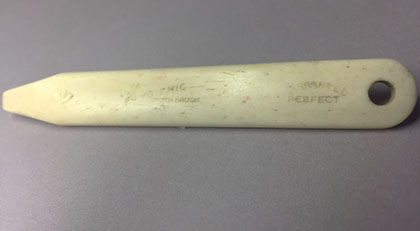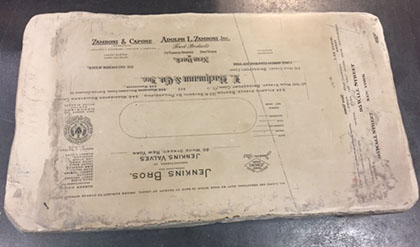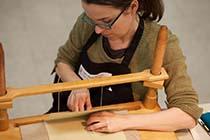Conservation Corner: Repurposing Tools
It was my intention to write a staid and informative blog post about brittle paper this week. However, while it may not yet be summer, it sure feels like it as I write this, and I think slightly lighter fare may be in order. And so, I bring you:
Repurposing Tools for Book Conservation
In a field as small as book conservation, equipment and tools tend to be expensive and only available from a few specialized vendors. Often we rely on antiques from the 19th and 20th centuries, which were industrialized bookbinding’s boom years. Antique book presses, board shears, and finishing tools for decorating leather bindings are especially prized.
Occasionally the perfect tool can be obtained by repurposing tools from other fields, or even from every day materials. Call it recycling, upcycling, or flagrantly ignoring manufacturer’s usage guidelines—whatever works!
Here are just a few examples from my bench:
 Toothbrush Bonefolder
Toothbrush Bonefolder
The bone folder is a staple of bookbinding and book conservation. Usually made of…you guessed it, bone, it is generally used for….well, folding. I no longer remember where I got this little bone folder, but it was a while before I realized that it was made from an old bone toothbrush handle. I also don’t know when the handle dates from, or when in the past it was repurposed, but I love the thought of my bookbinder predecessors making creative use of whatever was at hand.
(Here's a little more information about bone folders in general: https://jeffpeachey.com/2013/12/11/bone-folders-our-nearest-and-dearest-friend/)
Dental Tools and Scalpels
There is something undeniably medical about the practice of patching up broken books. Unsurprisingly, book conservation borrows a few tools from the medical profession. Dental instruments can be useful when excavating beneath delicate sewing. Scalpels are useful for just about everything, from paring small pieces of leather to lifting old cloth from covers. They also add a nice air of quiet intimidation to the conservation lab.
 Ace bandages
Ace bandages
Despite the suspicions of my colleagues, I do not tie up books with ace bandages merely for dramatic effect. Yes, they can be used to create an adorable book mummy. They are also an indispensable aid in holding reattached book spines in place while they dry.
Street Sweeper Bristle
I can think of few things in life that will make you feel more rugged than making a knife from a piece of metal you found on the street. Street sweepers shed their metal bristles with alarming frequency (maybe back up a few feet the next time one passes you by.) These little gems can often be found languishing on overlooked curbs, ripe for the taking. They are constructed from strong, flexible steel which can be sharpened into a blade. Perfect when you need to remove old leather from a curved spine, or cut around delicate sewing.
Sad irons
Having a good supply of small but very heavy weights on hand is a basic need of any book conservator. (Extra points if said weight happens to be cute.) They are generally used to keep items that are drying in the right shape, and to insure that glue adheres properly.
Sad irons are the cast iron cores of late 19th and early 20th century cloths irons. Heavy, compact, and durable, they can also be found on many book binder’s and conservator’s benches. (Why are they called “Asbestos Sad Irons?” They originally had an asbestos lined cover to contain heat. And “sad” because…well, I suppose ironing makes people sad. (More information can be found here: http://www.homethingspast.com/asbestos-sad-irons/)

Lithography stones
Lithography stones are slabs of limestone which are used in lithographic printing. They had their heyday in the 19th century, but are still used today for artistic prints. In addition for being an ideal surface for printing, they are also highly valued as leather paring surfaces. Their advantages are that they are perfectly smooth and level, while being soft enough not to damage paring knives.
(This is an important factor when it takes hours to sharpen your paring knives!)
Giving old tools new life is always satisfying, and can be the perfect solution to the trickiest conservation problems.


Disqus Comments